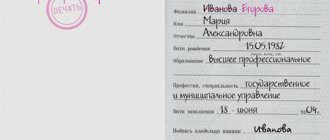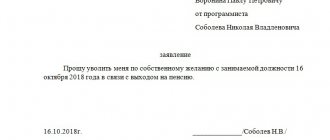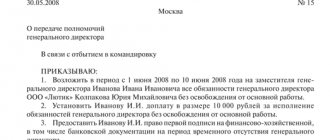Home / Labor Law / Labor book
Back
Published: 06/20/2018
Reading time: 5 min
2
549
Work books belong to strict reporting forms. Current legislation obliges all legal entities and entrepreneurs to maintain them. The document records the periods of work of the owner of the work book.
- Series and numbers
- How to check a document by series and number
- Validity
Series and number of TC
Each genuine work document, printed at Goznak and transferred through intermediaries to the employer, has identification numbers that allow it to be distinguished from others. Almost immediately after the form is produced, identifiers establish strict control over it and accompany it all the way to the owner:
- As a result of the production of forms at Goznak, where series and numbers are controlled during production.
- When transferring work forms and inserts to an intermediary by proxy, where the list contains the identifiers of each form.
- When purchasing forms by the employer, during which the identifiers are also reflected in the list in the act of their acquisition and in the power of attorney under which they are acquired.
- When entering forms into the accounting book, which is stored in the accounting department, as well as in the application, according to which the authorized person receives the TC form and their inserts.
An already completed book, which has become the property of the owner, can always be identified in the following cases:
- loss (read what to do if you lost your book - here);
- theft;
- fakes.
It can be identified by series and number, and its entire path along the chain of movement to the owner can be traced. These circumstances may be important when restoring the Labor Code or during legal proceedings, as well as in other cases that cannot always be foreseen.
When applying for a new place of work, the owner’s work book is registered in the labor register, where its series and number are also reflected. That is, practically no legal action is carried out without indicating the unique number and series of the book.
In essence, the identifier is the face of the book, as well as the citizen’s personal data entered into it.
Identification numbers and series are entered into the TC in a specific way:
- In old books they are written in red paint and written on 10 pages: 1,5,9,13,17,21,25,29,33,37, repeating exactly.
- In the new ones - on 11 pages: 1,3,9,15,19,23,27,31,33,37,39. Their series are made in black paint, and the numbers are red.
History of existence
The time of creation of the first labor force operating in the modern labor market was 1938. And today you can find them among workers who, due to their experience and good physical and mental health, continue to work. Their labor regulations were put into effect by order of the Council of People's Commissars of the USSR, approved on December 20, 1938 under No. 1320.
Until this moment, neither labor nor their analogues existed. By the time of their release, the concept that labor falsification could be carried out in the Soviet state was blasphemous. Therefore, neither a seal (see here) nor the signature of the responsible person was provided on their title pages, not to mention watermarks and other means of protection.
By 1974, these samples had become obsolete , since the work book had become an important document of national importance. The exchange of specialists from different republics required a political synthesis reflecting the meaning of the unity of workers, united by the slogan of the unity of the proletariat.
Based on these ideas, in accordance with the Resolution of the Council of Ministers of the USSR and the highest authority - the All-Union Central Council of Trade Unions, dated September 6, 1973, No. 656, it was decided to approve a new form of labor that meets modern requirements.
On April 21, 1975, “collective farmer’s work books” were approved, which became a global step in the history of labor legislation. Until 1975, many of the villagers, in principle, did not have the opportunity to leave their places of residence, completely deprived of documents.
https://youtu.be/UgjGFi6_h8A
Work books since 2004
In January 2004, a new form of work records was adopted. Their format was significantly reduced, and the cover became dark gray. The numbering of the series has changed, and until today the official letter mark is TK. The letter designation is black, and the serial number is red. As before, on the last page the data on which model the new book was made is indicated, namely: “© MPF Goznak. 2003. B" So, as for the new sample, it is not difficult to determine the work book number by year:
- TK - produced in 2004 and 2005}
- TK-I - in 2006 and 2007}
- TK-II – from 2008 to June 2010}
- TK-III – from June 2010 to 2012}
- TK-IV – from 2013 to the present.
The protection of work books in this series is made in the form of watermarks in the form of the letter combination “TK”, which are randomly located on the page and are visible only when translucent.
As for determining the number of work books before 1974, this is impossible, since neither a number nor a series were put on them. They had virtually no security and were therefore easy to counterfeit. The cover of the old books was dark purple.
Services of companies related to determining the year and series of issue of the work book
Some companies offer services in determining information about the exact time of issue of the work book. If you can independently find out whether the series of work books correspond to the years of issue of the work books, then for a fee such companies provide information about what month they were printed.
In addition, on some Internet sites you can order not only new-style books, but also old ones. They are also accompanied by inserts released in different years. The old form is being exchanged for a new one.
Such companies are popular not only with ordinary people, but also with collectors who are interested in a series of work books by year. They buy one or several books from different years and series. Particularly popular are the oldest copies, which were not marked with either a number or a series.
What did the 1974 TK look like?
- Dimensions TC 10x14 cm.
- Hardcover in dark green vinyl or calico. Some samples are in a blue-gray cardboard cover.
- The cover depicts the USSR Coat of Arms
- Cover page for filling out information about the employee.
- With a tabular line in the middle of the book for entering information about the work.
- Inside, the columns can contain tabular data with entries in the language of the union republics.
All sheets are provided with single-color, clear “snake” type watermarks, which are clearly and clearly visible in the light.
It is generally accepted that work books of this period had 40 pages . However, this is not entirely true, given that among them there are numerous labor union republics, which also included graphs in the language of the union republic for whose use they were issued. Thus:
- Labor records of the RSFSR had records only in Russian and consisted of 40 pages.
- The labor union republics had records in two languages and consisted of 80 pages.
Sample of an old-style work book:
TC of the perestroika period, produced in 1992
After the collapse of the USSR and the adoption of the Constitution of the Russian Federation, as well as the labor legislation of the Russian Federation, the state system did not have the right to continue issuing a document adopted in the Soviet Union and bearing its symbols, as well as protective signs. In the 90s, the work book lost its relevance as a form of recording work experience for citizens of the USSR.
During the same period, samples of light blue color with a grayish tint . Apart from the color and thin cardboard cover, they were practically no different from the standard dark green books that were in wide circulation.
On legal grounds they were identical. During this period, quite a lot of printed products were produced that did not meet the standard, including TC. Therefore, work books from the nineties often do not meet the requirements.
To bring them to standardization, the state decided to include its series and number in red in the Labor Code.
A sample of what work books were in 1992:
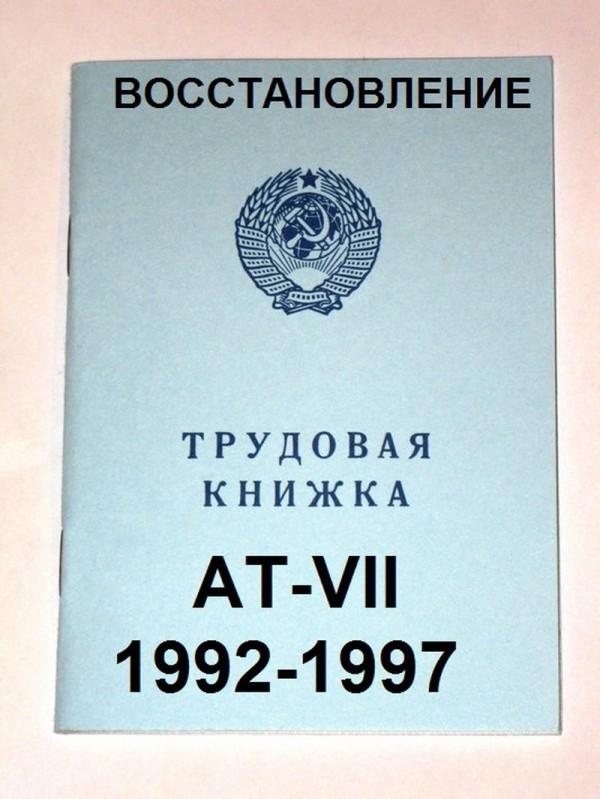
Correspondence of series and numbers of work books by year of issue for old samples
| Series of work books (LC) | Year of production TC |
| AT-1 | From 1974 to 1976 |
| AT-2 | From 1977 to 1979 |
| AT-3 | From 1980 to 1982 |
| AT-4 | From 1983 to 1985 |
| AT-5 | From 1990 to 1992 |
| AT-6 | From 1990 to 1992 |
| AT-7 | From 1993 to 1997 |
| AT-8 | From 1998 to 2000 |
| AT-9 | From 2001 to 2003 |
| New shopping malls | 2004 |
Introduction of new TKO forms The main documents stating the regulations of the new type of TK, defining the principles of filling them out and working with them on the basis of new forms of management are:
- Resolution of the PRF dated April 16, 2003 No. 225, which includes Rules for working with new types of technical equipment.
- Resolution of the Ministry of Labor dated October 10, 2003 No. 69, containing Instructions for working with new labor standards.
The need to introduce new forms of forms has become ripe due to the fact that the Russian legal system has become stronger and has introduced new forms of recording labor activity, based on the provisions of the Labor Code of the Russian Federation and fundamentally new forms of management, radically different from the Soviet ones.
However, a decision was made to keep in use all accounting documents through which the labor activities of citizens are carried out and monitored.
Years of issue of work books of the AT series
In Soviet times, and then Russian ones, from 1974 until the end of 2003, work books of the AT series .
Over such a long period, 10 series of this document were released, designated by Roman numerals. All work books from 1974 to 2003 have a “peculiarity”: at the bottom of the last page there should be the inscription “Goznak.1974”. It does not mean the year the document was issued, but simply that the book is from 1974. The year of issue is always determined by the series and number of the work book, which are located at the top of the first page. In those days, the series and numbers AT-I, AT-II, AT-III, AT-IV, AT-V, AT-VI, AT-VII were printed in red. On later samples, the color of the AT-VIII, AT-IX, AT-X series was black, and the work book number was red.
| № | Work books series | Year of release |
| 1. | AT - I | 1975, 1976 |
| 2. | AT - II | 1977, 1978, 1979 |
| 3. | AT - III | 1980, 1981, 1982 |
| 4. | AT - IV | 1983, 1984, 1985 |
| 5. | AT - V | 1986, 1987, 1988, 1989 |
| 6. | AT - VI | 1990, 1991, 1992 |
| 7. | AT - VII | 1993, 1994, 1995, 1996, 1997 |
| 8. | AT - VIII | 1998, 1999, 2000 |
| 9. | AT - IX | 2001, 2002, - first half of 2003 |
| 10. | AT - X | second half of 2003 |
The design of work books, as befits important documents, is in strict colors and discreet colors. Until 1982, they were issued in thick, dark green covers, and since 1983, they also appeared in use in blue-gray cardboard covers. The only difference was in the color and material of the cover, so we used both one option and the other. All pages of work books of the AT series from 1974 to 2003 are protected by watermarks: serpentine lines visible in direct light.
What do TCs from 2003 look like?
- TK 2003 release has dimensions 8.8x12.5 cm. The number of pages is 46.
- Hardcover in dark grey. This is usually paper or fabric vinyl.
- On the cover is the Coat of Arms of the Russian Federation.
- With a cover page for filling out information about the employee, which does not differ from the old samples.
- With a tabular layout in the middle of the book for entering information about the work, which does not differ from the old samples.
- Unlike the old books, it contains only graphs in Russian.
All sheets are protected with watermarks. Unlike the old samples, the signs here are multi-colored and have a complex pattern:
- Two-tone color, changing color towards the middle of the leaf.
- The mesh is quite fine, with a complex pattern.
- The letters "TK" are all over the sheet.
Sample of a new work book - what it looks like:
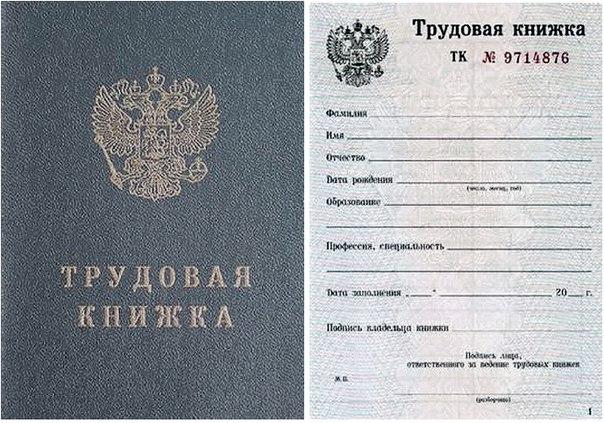
How do work books of the new sample differ from the old sample?
What is the difference between the new-style work books of 2003 and the old-style work books of 1974?
The new sample work book was introduced on January 1, 2004 by Decree of the Government of the Russian Federation of April 16, 2003. No. 225 “On work books.” The latest printing technologies and special equipment are used in the production of forms. The protection against counterfeiting has been enhanced compared to old work books. We use paper with chemical protection and the “TK” watermark. The printing uses complex graphic grids, special inks, and iris printing. The book is sewn with special threads and has a unique number on each sheet, which eliminates the possibility of replacing sheets. Its size coincides with the size of a Russian general passport. The cover is gray (previously it was green calico or blue paper), the texture of the covering material, made to special order, matches the texture of the passport cover, and the coat of arms of Russia is printed on it in gold foil. The corners of the work book are rounded.
The new type inserts have 36 sheets and are designed in the same way as the work book. The insert has a gray paper cover. The columns of the work book and the insert are made in accordance with the approved form.
Old-style work book.
Format 100x140mm, volume 40 pages, book contains 10 identical numbers.
Specifications
1.Paper.
70 g/sq.m., cotton pulp content: 100% bleached wood pulp.
Cover: blue cover paper weighing 200 g/sq.m (for work books).
2.Printing methods.
Inner sheets: offset - mesh and written - in two colors.
Letterpress - number.
Cover: offset - written in one color.
3.Protection elements.
Technological protection: general watermark in paper.
Printing protection: repeat mesh, reactive ink on the mesh.
Number - special paint.
Physico-chemical (special) protection - no.
There are hidden security features by which Goznak can carry out additional control of the authenticity of the work book.
New sample work book.
Format 88x125 mm, volume 46 pages, the book contains 11 identical numbers.
Specifications
1.Paper.
75 g/sq.m., cotton pulp content: 100% wood pulp, endpaper: 165 g/sq.m., cotton pulp content: 50% wood pulp. The shade of the paper is white. Background glow - internal l. - not>0.6 cd/w, bookend - not>0.7 cd/w. under the influence of UV radiation.
Cover: gray textile binding material (for work books).
Cover paper 200 g/sq.m. blue (for liner).
2.Printing methods.
Inner sheets: offset - 5 colors - 2 grids, one of them with an iris roll, cursive with lettering and a special element (lilac, lilac-blue, black, colorless).
Endpaper: offset, grid in one color, gray.
Letterpress : number and series in one color, red.
Cover : foil text “Luxor 220” (work book).
Black foil text “Colorit V 912” (inlay).
3.Protection elements.
Technological protection: internal sheets - a common three-tone watermark in paper with the letters “TK”, visible fibers with alternating sections of variable cross-section: red does not glow in UV rays, painted yellow glows yellow in UV rays, visible fibers are green colors glow yellow-green in UV rays; flyleaf - low-visibility green and yellow fibers glow yellow-green and yellow in UV rays, respectively.
Printing protection: ext. l.-2 non-rapport guilloche grids, one of them with iris, microtext - three rulers on the title page, flyleaf - wavy assur grid.
Physico-chemical (special) protection: paint on a mesh without iris is special, text is paints that are metameric in IR absorption, an invisible special element glows yellow-green in UV rays, the number is magnetic paint.
Special paints:
Colorless, luminescent under UV radiation:
Special element - on odd-numbered pages (in inserts except the first page) it glows yellow-green.
Visible, luminescent under IR radiation: invisible special element - green glow.
Metameric by IR radiation: text on internal pages
Magnetic: no.
Other special paints: paint on a grid without iris roll - lilac - special paint.
Graphic elements:
Background guilloche grids overlapping each other (rapport, iris, line width, colorfulness):
Inner sheets: 1 non-rapport guilloche mesh with a relief pattern with an iris roll in two colors, the blue color in the center turns into lilac.
2 non-rapport guilloche mesh in one color, lilac.
Endpaper: 1 mesh wavy assure in one color, gray.
Microtext (height, location): 190 microns. - three sublinear rulers on the title.
There are hidden signs of protection, according to which Goznak can conduct additional
Correspondence of TK inserts to the years of their production
| Series of inserts TK | Year of release of the insert |
| AT-I | From 1974 to 1980 |
| AT - II | From 1981 to 1987 |
| AT - III | From 1988 to 1994 |
| AT - IV | From 1995 to 2003 |
| VT | From 2004 to present |
According to experienced personnel officers with extensive experience who have had the opportunity to work with old insert forms, their cover is much thinner, and so are the sheets. This fact made it much easier to sew the insert into the book (see here).
In addition, the forms have visible differences:
- In the old inserts, the Coat of Arms of the USSR was located in the upper left corner, and in the new ones - the Coat of Arms of the Russian Federation.
- Watermarks visible against light correspond to those applied to work books of the corresponding year of issue.
Unfortunately, irresponsible personnel officers, mainly in the 90s, committed serious violations in the preparation of inserts in the work book, which now affects the problems of citizens applying for pensions. Violations include:
- Sheets from another work book sewn or pasted into the TC.
- Regular sheets lined in the form of graphs.
- Inserts made in a simple typographic way.
These and other violations create a precedent for the unsuitability of the Labor Code.
In such cases, the employer has to warn the employee that his labor must be replaced in part of the glued liner.
Series of inserts in the work book by year
The series of each insert always directly depends on the year of manufacture of the main sample
work books corresponding to the 1974 model:
- 1975-1976 – AT-I}
- 1977-1979 – AT-II}
- 1980-1982 – AT-III}
- 1983-1985 – AT-IV}
- 1986-1988 – AT-V}
- 1989-1992 – AT-VI}
- 1993-1998 – AT-VII}
- 1999-2001 – AT-VIII}
- 2002-2003 – AT-IX}
work books that correspond to the 2003 model:
- 2004-2005 – TK}
- 2006-2007 – TK-I}
- 2008-2010 – TK-II.
The following are a series of inserts in the work book in chronological order:
- 1975-1979 —} *AT-I}
- 1980-1986 —} *AT-II}
- 1987-1993 – *AT-III}
- 1994-2003 – *AT-IV}
- 2004-2010 – a series of inserts for labor – VT.


